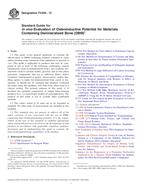We need your consent to use the individual data so that you can see information about your interests, among other things. Click "OK" to give your consent.
ASTM F3089-14
Standard Guide for Characterization and Standardization of Polymerizable Collagen-Based Products and Associated Collagen-Cell Interactions
STANDARD published on 1.5.2014
The information about the standard:
Designation standards: ASTM F3089-14
Note: WITHDRAWN
Publication date standards: 1.5.2014
SKU: NS-54925
The number of pages: 17
Approximate weight : 51 g (0.11 lbs)
Country: American technical standard
Category: Technical standards ASTM
The category - similar standards:
Annotation of standard text ASTM F3089-14 :
Keywords:
biomaterials, characterization, collagen-cell interactions, collagen polymer, self-assembly, tunable, ICS Number Code 11.100.99 (Other standards related to laboratory medicine)
Additional information
| Significance and Use | ||||||||||||||||||||||||||||||||||||||||||||||||||||||||||||||||||||||||||||||||||||||||||||||||||||||||||||||||||||||||||||
|
4.1 The objective of this document is to provide guidance in the production, characterization, testing, and standardization of: (a) collagen polymers as a starting material for surgical implants, substrates for tissue-engineered medical products (TEMPs), vehicles for therapeutic cells and molecules, and 3D in-vitro tissue systems for basic research, drug development, and toxicity testing; and 4.2 The collagen covered by this guide may be used in a broad range of applications, forms, or medical products, for example (but not limited to) wound and hemostatic dressings, surgical implants or injectables, hybrid medical devices, tissue-engineered medical products (TEMPs), injectable or implantable delivery vehicles for therapeutic cells, molecules, and drugs, and 3D in-vitro tissue systems or models for basic research, drug development, and toxicity testing. The practical application of the collagen polymers and associated self-assembled collagen-based materials should be based, among other factors, on biocompatibility, application-specific performance measures, as well as chemical, physical, and biological test data. Recommendations in this guide should not be interpreted as a guarantee of success for any research or medical application. 4.3 The following general areas should be considered when determining if the collagen supplied satisfies requirements for use in the above mentioned medical and research applications: source of collagen polymer, impurities profile, and comprehensive chemical, physical, and biological characterization and testing. 4.4 The following documents or other relevant guidances from appropriate regulatory bodies relating to the production, regulation, and regulatory approval of devices, biologics, drugs, and combination products should be considered when determining if the collagen supplied satisfies requirements for use in medical and research products, including TEMPs, therapeutic delivery vehicles, and 3D in-vitro tissue systems:
|
||||||||||||||||||||||||||||||||||||||||||||||||||||||||||||||||||||||||||||||||||||||||||||||||||||||||||||||||||||||||||||
| 1. Scope | ||||||||||||||||||||||||||||||||||||||||||||||||||||||||||||||||||||||||||||||||||||||||||||||||||||||||||||||||||||||||||||
|
1.1 This guide for characterizing polymerizable collagens is intended to provide characteristics, properties, test methods, and standardization approaches for use by producers, manufacturers, and researchers to identify specific collagen polymer formulations and associated self-assembled collagen-based products produced with these formulations. This guide will focus on the characterization of polymer forms of Type I collagen, which is the most abundant collagen in mammalian connective tissues and organs, including skin, bone, tendon, and blood vessels. Type I collagen may be derived from a variety of sources including, but not limited to, animal or cadaveric tissues, cell culture, recombinant, and chemical synthesis. This guide is intended to focus on purified Type I collagen polymers as a starting material for wound and hemostatic dressings, surgical implants, substrates for tissue-engineered medical products (TEMPs), delivery vehicles for therapeutic cells or molecules, and 3D in-vitro tissue systems for basic research, drug development, and toxicity testing. Polymerizable or self-assembly implies that the collagen composition exhibits spontaneous macromolecular assembly from its components in the absence of the addition of exogenous factors including cross-linking agents. Self-assembling collagen polymers may include, but are not limited to: (1) tissue-derived atelocollagens, monomers, and oligomers; (2) collagen proteins and peptides produced using recombinant technology; and 1.2 The ability of self-assembled collagen materials to guide cellular responses through provision of cellular adhesion and proteolytic domains as well as physical constraints (for example, structural, cell-matrix traction force) has been well documented through extensive clinical (1, 2)2 and basic research studies 1.3 The values stated in SI units are to be regarded as standard. No other units of measurement are included in this standard. 1.4 Warning—Mercury has been designated by the Environmental Protection Agency (EPA) and many state agencies as a hazardous material that can cause central nervous system, kidney, and liver damage. Mercury, or its vapor, may be hazardous to health and corrosive to materials. Caution should be taken when handling mercury and mercury-containing products. See the applicable product Material Safety Data Sheet (MSDS) for details and the EPA website (http://www.epa.gov/mercury/faq.htm) for additional information. Users should be aware that selling mercury or mercury-containing products, or both, in your state may be prohibited by state law. 1.5 The following precautionary caveat pertains only to the test method portion, Section 5, of this guide. This standard does not purport to address all of the safety concerns, if any, associated with its use. It is the responsibility of the user of this standard to establish appropriate safety and health practices and determine the applicability of regulatory limitations prior to use. |
||||||||||||||||||||||||||||||||||||||||||||||||||||||||||||||||||||||||||||||||||||||||||||||||||||||||||||||||||||||||||||
| 2. Referenced Documents | ||||||||||||||||||||||||||||||||||||||||||||||||||||||||||||||||||||||||||||||||||||||||||||||||||||||||||||||||||||||||||||
|
Similar standards:
Historical
1.3.2012
Historical
1.2.2013
Historical
15.10.2010
Historical
1.12.2011
Historical
1.4.2012
Historical
1.3.2011
We recommend:
Technical standards updating
Do you want to make sure you use only the valid technical standards?
We can offer you a solution which will provide you a monthly overview concerning the updating of standards which you use.
Would you like to know more? Look at this page.



 ASTM F2459-12
ASTM F2459-12 ASTM F2529-13
ASTM F2529-13 ASTM F2808-10
ASTM F2808-10 ASTM F2883-11
ASTM F2883-11 ASTM F2884-12
ASTM F2884-12 ASTM F2903-11
ASTM F2903-11
 Cookies
Cookies
